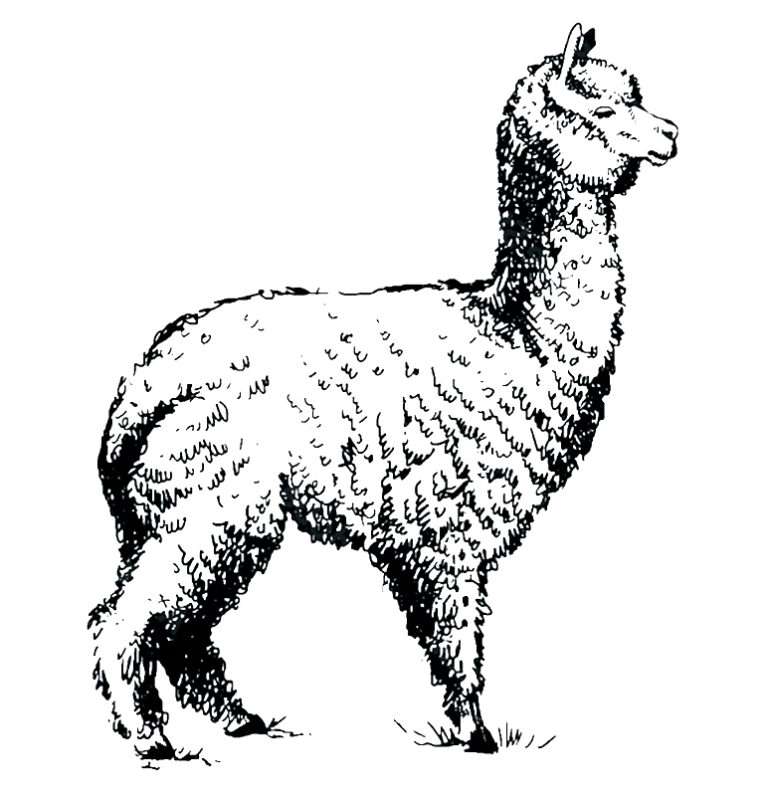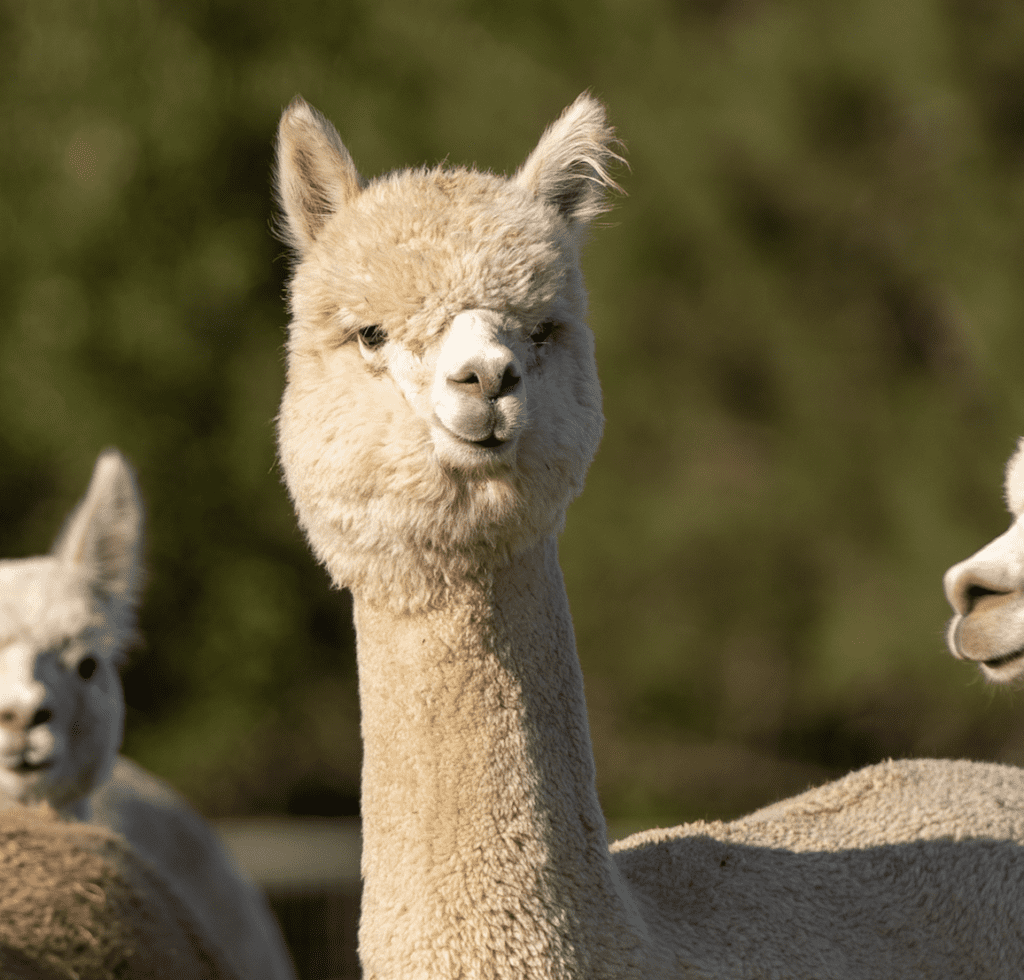The alpaca (Lama pacos) is a mammal native to South America and is often mistaken for its larger cousin, the llama. However, alpacas are generally smaller in size and were bred specifically for their fiber rather than as working animals. They are closely related to the vicuña and guanaco, and two breeds exist: the Suri and Huacaya alpaca.Alpacas graze on the level heights of the Andes, primarily in Southern Peru, Western Bolivia, Ecuador, and Northern Chile, at high altitudes ranging from 3,500 to 5,000 meters above sea level. Their fiber is highly valued in the textile industry and is used to make a wide variety of knitted and woven items, including blankets, sweaters, hats, gloves, scarves, and ponchos.
Alpaca fiber comes in over 52 natural colors, as classified in Peru, and is known for its softness, durability, and insulation properties. Alpacas communicate through body language, with spitting being a common behavior to show dominance, fear, or agitation. Male alpacas tend to be more aggressive than females and establish dominance within their herd.In the textile industry, the term “alpaca” typically refers to fabric made from Peruvian alpaca hair, although it can also refer to fabrics made from other types of animal hair, such as mohair or Icelandic sheep wool. Alpacas typically measure between 81 and 99 centimeters in height at the shoulders and weigh between 48 and 90 kilograms, with males being slightly heavier than females.
アルパカ(Lama pacos)は、南アメリカ原産の哺乳類で、よく従兄弟のラマと間違えられます。しかし、アルパカは一般にサイズが小さく、労働動物としてではなく、繊維をとるために特別に飼育された。ビクーニャやグアナコと近縁で、スリ族とフアカヤ族の2種が存在する。 アルパカは、ペルー南部、ボリビア西部、エクアドル、チリ北部を中心としたアンデス山脈の標高3,500~5,000mの高地で草を食んでいます。その繊維は繊維産業で高く評価され、毛布、セーター、帽子、手袋、スカーフ、ポンチョなど、さまざまなニットや織物の材料として使用されています。
アルパカ繊維は、ペルーで分類された52色以上の天然色があり、柔らかさ、耐久性、保温性で知られています。アルパカはボディランゲージでコミュニケーションをとり、唾を吐くことで優位性、恐怖、興奮を示すのが一般的な行動である。オスのアルパカはメスよりも攻撃的で、群れの中で優位性を確立する傾向がある。 繊維業界では、「アルパカ」という言葉は一般的にペルー産アルパカの毛を使った生地を指すが、モヘアやアイスランド産羊毛など他の種類の動物の毛を使った生地も指すことがある。アルパカの大きさは、肩の高さが81〜99cm、体重は48〜90kgで、オスの方がメスより若干重いのが一般的である。
Alpacas were domesticated thousands of years ago. The Moche people of Northern Peru often used alpaca images in their art. There are no known wild alpacas, and its closest living relative, the vicuña (also native to South America), is the wild ancestor of the alpaca.
The family Camelidae first appeared in Americas 40–45 million years ago, during the Eocene period, from the common ancestor, Protylopus. The descendants divided into Camelini and Lamini tribes, taking different migratory patterns to Asia and South America, respectively. Although the camelids became extinct in North America around 3 million years ago, it flourished in the South with the species we see today. It was not until 2–5 million years ago, during the Pliocene, that the genus Hemiauchenia of the tribe Lamini split into Palaeolama and Lama; the latter would then split again into Lama and Vicugna upon migrating down to South America.
Remains of vicuña and guanaco have been found throughout Peru for around 12,000 years. Their domesticated counterparts, the llama and alpacas, have been found mummified in the Moquegua valley, in the south of Peru, dating back 900 to 1000 years. Mummies found in this region show two breeds of alpacas. More precise analysis of bone and teeth of these mummies has demonstrated that alpacas were domesticated from the Vicugna vicugna. Other research, considering the behavioral and morphological characteristics of alpacas and their wild counterparts, seems to indicate that alpacas could find their origins in Lama guanicoe as well as Vicugna vicugna, or even a hybrid of both.
Genetic analysis shows a different picture of the origins of the alpaca. Analysis of mitochondrial DNA shows that most alpacas have guanaco mtDNA, and many also have vicuña mtDNA. But microsatellite data shows that alpaca DNA is much more similar to vicuña DNA than to guanaco DNA. This suggests that alpacas are descendants of the Vicugna vicugna, not of the Lama guanicoe. The discrepancy with mtDNA seems to be a result of the fact that mtDNA is only transmitted by the mother, and recent husbandry practices have caused hybridization between llamas (which primarily carry guanaco DNA) and alpacas. To the extent that many of today’s domestic alpacas are the result of male alpacas bred to female llamas, this would explain the mtDNA consistent with guanacos. This situation has led to attempts to reclassify the alpaca as Vicugna pacos.
アルパカは数千年前に家畜化されました。ペルー北部のモチェ族は、アルパカのイメージをよく美術品に使っていた。野生のアルパカは確認されておらず、最も近縁のビクーニャ(南米原産)がアルパカの野生の祖先とされている。ラクダ科は、4000〜4500万年前の始新世に、共通の祖先であるProtylopusから初めてアメリカ大陸に出現した。その子孫は、カメリーニ族とラミニ(ラマ)族に分かれ、それぞれ異なる移動パターンでアジアと南米に移動した。ラクダ科は300万年前頃に北米で絶滅したが、南米では現在のような種で栄えた。ラミニ族ヘミアウケニア属がパラオラマとラマに分かれたのは200-500万年前の鮮新世で、ラマは南米に下ってから再びラマとビクーニャに分かれることになる。ビクーニャとグアナコの遺体は、約12,000年前からペルー全土で発見されている。家畜化されたラマとアルパカは、ペルー南部のモケグア渓谷で900年から1000年前にミイラ化したものが発見されている。この地方で発見されたミイラには、2種類のアルパカが確認されている。これらのミイラの骨や歯をより精密に分析した結果、アルパカはビクーニャvicugnaから家畜化されたものであることが証明された。他の研究では、アルパカと野生のアルパカの行動的、形態的特徴を考慮すると、アルパカの起源はビクーニャ・ビクーニャと同様にラマ・グァニコー、あるいは両者の混血である可能性があるようだ。遺伝子の分析では、アルパカの起源について異なる見解が示されている。ミトコンドリアDNAの分析では、ほとんどのアルパカがグアナコのmtDNAを持っており、また多くのアルパカがビクーニャのmtDNAを持っていることがわかった。しかし、マイクロサテライトのデータによると、アルパカのDNAはグアナコのDNAよりもビクーニャのDNAに非常によく似ていることがわかります。このことは、アルパカがラマ・グアナコの子孫ではなく、ビクーニャの子孫であることを示唆している。mtDNAとの不一致は、mtDNAが母親からしか伝わらないこと、近年の飼育方法によって、主にグアナコのDNAを持つラマとアルパカが交雑したことが原因と思われる。現在の国産アルパカの多くが、アルパカの雄とラマの雌を交配させた結果であることを考えると、グアナコと一致するmtDNAの説明がつくのである。このような状況から、アルパカをVicugna pacosに再分類する試みがなされている。
The history of alpacas in Europe is relatively recent, dating back to the early 19th century when they were first imported from South America. The first recorded importation of alpacas to Europe was in 1806 when a male and female pair were sent to Spain by the Viceroyalty of Peru as a gift to King Charles IV.From there, the alpacas were transported to other parts of Europe, including France, Germany, and England. In England, alpacas were primarily kept as curiosities and exotic pets by the wealthy, and they were often featured in zoos and private collections. However, some individuals recognized the value of alpaca fiber and began breeding them for their wool.
The first successful alpaca breeding program in Europe was established in Germany in the mid-19th century, and by the end of the century, alpaca farming had spread to other parts of Europe, including Italy, Austria, and Switzerland.Today, alpaca farming is a growing industry in many parts of Europe, with breeders focusing on improving the quality of alpaca fiber and developing new markets for alpaca products. The majority of alpaca farms in Europe are small-scale operations, with most farms having fewer than 50 animals. However, there are also some larger farms that have several hundred animals and are focused on commercial production.
ヨーロッパにおけるアルパカの歴史は比較的新しく、19世紀初頭に南米から輸入されたのが最初と言われています。アルパカがヨーロッパに初めて輸入されたのは、1806年、ペルー王国が国王チャールズ4世への贈り物としてオスとメスのペアをスペインに送り、そこからフランス、ドイツ、イギリスなど、ヨーロッパの各地に輸送されたのが記録されています。イギリスでは、アルパカは主に富裕層が珍重するペットとして飼育され、動物園や個人のコレクションとして取り上げられることが多かった。しかし、アルパカの繊維の価値を認め、羊毛のためにアルパカの飼育を始める人が現れました。
アルパカの飼育は、19世紀半ばにドイツで初めて成功し、19世紀末にはイタリア、オーストリア、スイスなどヨーロッパ各地に広まった。ヨーロッパのアルパカ農家は、50頭以下の小規模農家が大半を占めています。しかし、数百頭を飼育する大規模な農場もあり、商業生産に力を入れている。
Alpacas have been an important part of the cultural and economic history of South America for thousands of years. The domestication of alpacas is believed to have begun around 5,000 years ago in the Andean region of South America, where they were bred for their fiber, meat, and use as pack animals.The Inca civilization, which flourished in the Andes between the 13th and 16th centuries, placed a high value on alpacas and their wool. Alpacas were considered sacred animals, and their wool was reserved for the clothing and bedding of Inca royalty and nobility. The Inca also used alpacas as pack animals to transport goods across the rugged Andean terrain.
Following the Spanish conquest of South America in the 16th century, the alpaca industry suffered a significant decline. The Spanish colonizers viewed alpacas primarily as a source of meat and hides and did not place the same value on their wool as the Inca. Many alpaca herds were destroyed, and their numbers were greatly reduced. However, the alpaca industry began to recover in the 19th century, as the value of alpaca wool was rediscovered. Alpacas were once again bred for their fiber, and their numbers gradually increased. Today, alpacas are an important part of the agricultural and cultural heritage of many South American countries, including Peru, Bolivia, and Chile.
However, the alpaca industry began to recover in the 19th century, as the value of alpaca wool was rediscovered. Alpacas were once again bred for their fiber, and their numbers gradually increased. Today, alpacas are an important part of the agricultural and cultural heritage of many South American countries, including Peru, Bolivia, and Chile.
アルパカは数千年にわたり、南米の文化・経済の歴史に重要な役割を果たしてきた。13世紀から16世紀にかけてアンデス地方で栄えたインカ文明では、アルパカとその毛が重要視された。アルパカは神聖な動物として扱われ、その毛はインカの王族や貴族の衣服や寝具に使用された。また、インカ帝国はアルパカを荷馬車として使用し、アンデスの険しい地形を越えて物資を輸送していた。 16世紀にスペインが南米を征服した後、アルパカ産業は大きく衰退した。スペイン人はアルパカを肉や皮の材料とし、インカのように羊毛に価値を見いだすことはなかった。多くのアルパカの群れは破壊され、その数は大幅に減少した。しかし、19世紀に入り、アルパカの毛の価値が再認識され、アルパカ産業は回復に向かう。アルパカは、繊維をとるために再び飼育されるようになり、その数は次第に増えていった。現在では、ペルー、ボリビア、チリなど南米の多くの国で、アルパカは農業・文化遺産として重要な位置を占めている。 しかし、19世紀に入り、アルパカの毛の価値が再認識され、アルパカ産業は回復に向かう。アルパカは再び繊維のために飼育されるようになり、その数は徐々に増えていった。現在、アルパカはペルー、ボリビア、チリなど南米各国の農業・文化遺産として重要な位置を占めている。
www.DeepL.com/Translator(無料版)で翻訳しました。
L’impératrice Joséphine, par Pierre-Paul Prud’hon, Musée du Louvre © art.rmngp.fr







